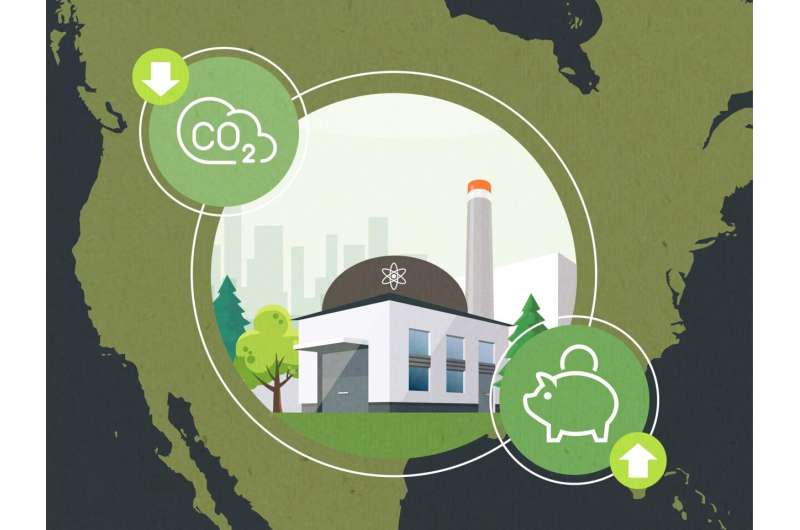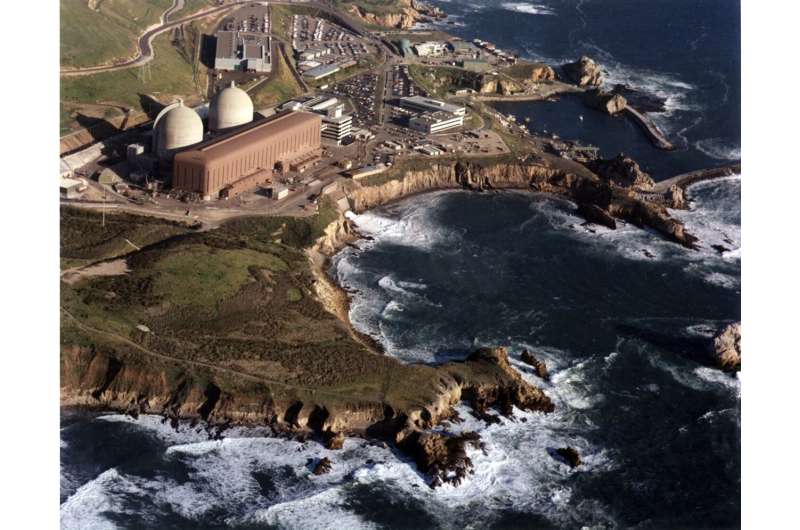Sustaining US nuclear power plants could be key to decarbonization

Nuclear power is the single largest source of carbon-free energy in the United States and currently provides nearly 20 percent of the nation’s electrical demand. Many analyses have investigated the potential of future nuclear energy contributions in addressing climate change. However, few assess the value of existing nuclear power reactors.
Research led by Pacific Northwest National Laboratory (PNNL) Earth scientist Son H. Kim with the Joint Global Change Research Institute (JGCRI), a partnership between PNNL and the University of Maryland, has added insight to the scarce literature and is the first to evaluate nuclear energy for meeting deep decarbonization goals. Kim sought to answer the question: Just how much do our existing nuclear reactors contribute to the mission of meeting the country’s climate goals, both now and if their operating licenses were extended?
As the world races to discover solutions for reaching net zero, Kim’s report quantifies the economic value of bringing the existing nuclear fleet into the year 2100 and outlines its significant contributions in limiting global warming.
Plants slated to close by 2050 could be among the most important players in a challenge that requires all carbon-free technology solutions that are available—emerging and existing—the report finds. New nuclear technology also has a part to play, and its contributions could be boosted by driving down construction costs.
“Even modest reductions in capital costs could bring big climate benefits,” said Kim. “Significant effort has been incorporated into the design of advanced reactors to reduce the use of all materials in general, such as concrete and steel, because that directly translates into reduced costs and carbon emissions.”
Nuclear power reactors face an uncertain future
The nuclear power fleet in the United States consists of 93 operating reactors across 28 states. Most of these plants were constructed and deployed between 1970-1990. This means half of the fleet has outlived its original operating license lifetime of 40 years. While most reactors have had their licenses renewed for an additional 20 years, and some for yet another 20, the total number of reactors that will receive a lifetime extension to operate a full 80 years from deployment is uncertain.
Other countries also rely on nuclear energy. In France, for example, nuclear energy provides 70 percent of the country’s power supply. They and other countries will also have to consider whether to extend the lifetime, retire, or build new, modern reactors. However, the U.S. faces the potential retirement of a bulk of reactors in a short period of time—this could have a far stronger impact than the staggered closures other countries may experience.
“Our existing nuclear power plants are aging and with their current 60-year lifetimes, nearly all of them will be gone by 2050. It’s ironic. We have a net zero goal to reach by 2050, yet our single largest source of carbon-free electricity is at risk of closure,” said Kim.
Exploring scenarios of lifetime extensions for nuclear power reactors
Kim has built computational models that explore the interplay between economic processes, energy demand, and Earth’s climate since joining PNNL and JGCRI in 1995, when he was a doctoral intern with a fresh Ph.D. in nuclear engineering. At JGCRI, researchers explore interactions between human, energy, and environmental systems to provide data for managing risks and analyzing options. His research is inspired by a drive to solve the energy and environmental crisis using modeling capabilities and tools like the Global Change Analysis Model (GCAM), developed at PNNL.
Kim used GCAM to model multiple scenarios of extending the lifetime of the existing nuclear fleet into 2100. The article, published in Nuclear Technology, put a value on lifetime license extensions from 40 to 100 years at $330 billion to $500 billion in mitigation cost savings under a scenario that limits global temperature to 2°C. Mitigation costs savings, or the carbon value, are amounts of dollars saved in reducing greenhouse gas emissions. Legacy nuclear reactors alone have a carbon value of $500 billion if operational for 100 years. Every gigawatt of energy, or one nuclear power reactor, translates to $5 billion later saved. Because that gigawatt was produced without any carbon emitted into Earth’s atmosphere, no money would need to be spent to mitigate its effects.
Maintaining existing nuclear power plants avoids replacing reactors with electricity sources that produce carbon emissions. In states where nuclear reactors have been shut down, carbon emissions have increased from replacing the carbon-free electricity with natural gas-generated electricity.

Kim determined that lifetime extensions of existing nuclear power reactors from 60 to 80 years, without adding new nuclear capacity, contributed to a reduction of approximately 0.4 gigatons of carbon (GtCO2) emissions per year by 2050. The total cumulative difference in CO2 emissions between 2020 and 2100, in a scenario with lifetime extensions and future deployment of nuclear power plants (as compared to a scenario with a moratorium on new nuclear power plants), amounts to as much as 57 GtCO2.
How much is 57 GtCO2? According to the International Energy Agency, U.S. carbon emissions in 2022 were 4.7 Gt, which means nuclear energy could save approximately 12 years’ worth of carbon emissions.
An Intergovernmental Panel on Climate Change report on nuclear energy stated, “Nuclear power is therefore an effective greenhouse gas (GHG) mitigation option, especially through license extensions of existing plants enabling investments in retro-fitting and upgrading.”
However, in a follow-on report to his research, Kim addresses the additional savings potential of driving down capital costs of building new nuclear power plants.
Removing the uncertainty in nuclear power costs can increase emissions savings
Building new nuclear power plants is expensive and construction takes a long period of time. The largest costs are often capital costs: the one-time price paid to build new structures and equipment.
Advanced reactors—including small modular reactors and microreactors—are being developed with new technologies, enhanced security features, smaller physical footprints, and more flexible deployment options. They are expected to play an important role in the future U.S. electricity system and carbon mitigation efforts.
“One of most important attributes of small modular reactors and microreactors is the reduced construction time,” Kim said. “SMRs and microreactors will be factory fabricated and delivered to site on trucks, and the uncertainty associated with financing cost should be reduced or eliminated.”
Kim used GCAM to investigate a range of nuclear plant capital costs with scenarios of alternative carbon mitigation policies, and U.S. economy-wide net-zero emission goals by 2050, 2060, and 2070.
Among the multiple findings in the report for DOE’s Office of Nuclear Energy, Kim found that an aggressive reduction of nuclear construction costs has a clear and pronounced impact on the expanded deployment of nuclear power under all scenarios, even without an explicit carbon mitigation policy.
Continuing to generate electricity while removing all emissions of greenhouse gases by mid-century is a difficult challenge. “We must utilize all carbon-free technologies that are available to us,” said Kim, “and one of the great values of nuclear energy is that it doesn’t emit carbon while it’s generating power.”
Citation:
Sustaining US nuclear power plants could be key to decarbonization (2023, May 2)
retrieved 2 May 2023
from https://techxplore.com/news/2023-05-sustaining-nuclear-power-key-decarbonization.html
This document is subject to copyright. Apart from any fair dealing for the purpose of private study or research, no
part may be reproduced without the written permission. The content is provided for information purposes only.
For all the latest Technology News Click Here
For the latest news and updates, follow us on Google News.
